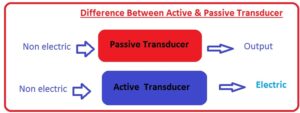 Hello, friends, I hope you all are doing great. In today’s tutorial, we will discuss the Difference Between Active & Passive Transducer. there is no need of an exterior power supply for the production of output in the active transducer while for passive transducer exterior power supply is required.
Hello, friends, I hope you all are doing great. In today’s tutorial, we will discuss the Difference Between Active & Passive Transducer. there is no need of an exterior power supply for the production of output in the active transducer while for passive transducer exterior power supply is required.
The physical quantities such as pressure, displacement, temperature, can not measure easily. To measure these values any instrument is needed that transforms them into the measurable form. For these conversion devices used are called a transducer. In today’s post, we will have a detailed look at both active and passive transducers with the details and find their differences. So let’s get started with Difference Between Active & Passive Transducer.
Difference Between Active & Passive Transducer
Active Transducer
- It is a type of transducer that transforms such signal in the electrical that is nonelectric.
- The example of nonelectrical parameters are temperature, pressure, light, etc
- It does not need any exterior energy source for operation.
- Normally three main types of active transducer piezo electric, thermal and photo.
- It working operation based on the use of power from the measured quantity.
- Its physical design is simple than the passive transducer.
- Its resolution is less.
- It is such sensitive very less change can measure throguh it
- Its examples are tacho generator, Thermocouple, Photovoltaic cell.
- It generated an output signal from the signal to be measured.
Passive Transducer
- The type of transducer whose interior factors such as capacitance, resistance, and inductances vary with the change of input is called a passive transducer.
- Its main types are resistive, capacitive, and inductive.
- For operation, it needed an extra power source.
- LVDT is a type of transducer that generates the electric signal according to the change in position of the body.
- LVDT is like a transformer having a core that can be change postion
- It generated output with the use of an exterior signal.
- LVDT used to measure the displacement used in satellite
- Examples of passive transducers are Thermistor, Differential transformer, Photomultiplier tube, Photovoltaic cell.
- Its working principle depends on that it uses exterior power to vary the exterior parameters of the transducer.
- Its design is complicated than the active transducer.
- LDR is also a passive transducer that works as a light detecting device.
- Ldr employed in-camera for light detection
- The potentiometer is a transducer that used to measure the rotational displacement.
- Reostate is a transducer used to finds linear displacement
- Its resolution is larger than the active transducer.
That is all about the difference between active and passive transducer. If you have any query ask in comments. Thanks for reading. Have a good day.






